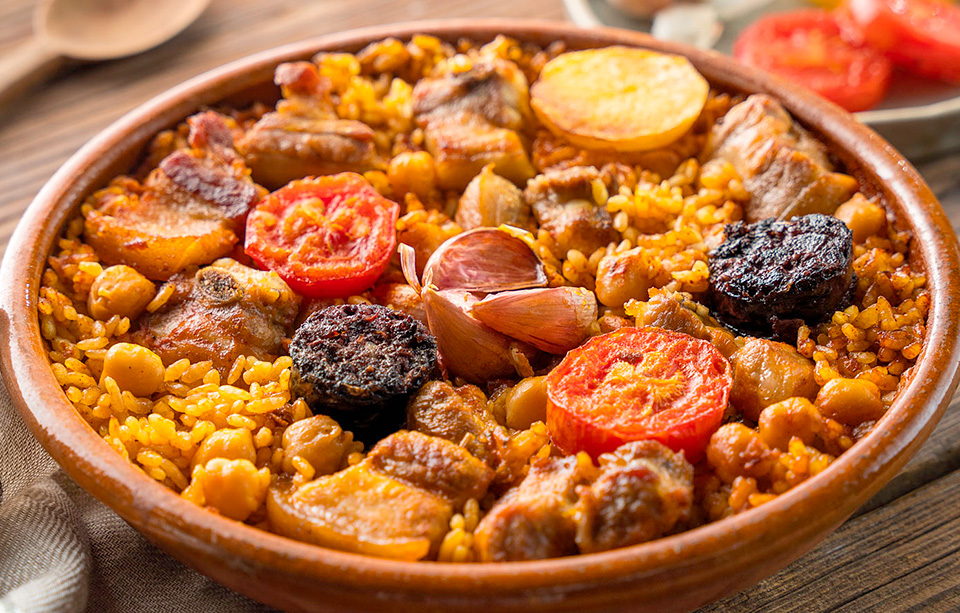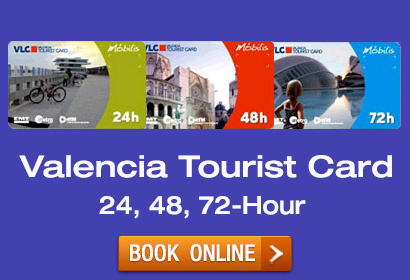The Valencia's food and drink is characterised by its Mediterranean flavour, the richness of its ingredients and the simplicity of its preparation, and is highly prized by the most discerning of palates. Its most typical dishes is made by ingredients like rice, oranges, seafood and fresh fruit and vegetables.
Its traditionally-produced sweets, many of which are of Arab origin, including coca moruna, arrop i tallaetes, arnadí and pastissets de moniato.
Arròs al forn (baked rice)
A dry rice dish made in the oven in a pottery dish, often using the stock from the stew made the previous day, accompanied by pork (fatty pork, lips, ears, black pudding), chick peas, tomato and garlic. Xàtiva, 58 kilometres from Valencia, is the traditional place to eat this dish.
Arròs amb fesols i naps (rice with green beans and turnips)
A dish with stock where the rice is prepared along with green beans (fesols) and turnips (naps). It is normally a winter dish as the vegetables are combined with a lot of pork (trotters, head, etc.)
Arròs a banda (rice and fish)
This is a fisherman's dish, traditionally eaten in coastal areas. Although it is made with fish stock and prawns, it has humble origins. The dish doesn't need expensive fish because, as the name suggests, the rice and fish are cooked in separate pans ("a banda"), to finally "dry" the rice with the fish stock.
Fideuà
This was originally a humble fishermen's dish. Gandia, and generally speaking the Safor area, is its birthplace and the area that has made it famous, as the "International Fideuà Contest" is held there every year. The fideuà is made in almost the same way as arròs a banda, but using noodles instead of rice.
The dish also requires: morralla (prawns, crab, small monkfish, etc.) and a grouper or swordfish bone (using this with bay leaf and a whole onion in its skin to prepare the stock).
All i pebre
This is the second most important local dish and one of the best-known in Valencia. It's no accident that its name contains two of the ingredients used to make it: garlic and eels.
This stew comes form the marshes, more exactly the island of El Palmar, where it is very popular indeed. It consists of fresh eels, garlic, paprika, chilli peppers, oil, a little water, salt and potatoes. This is the traditional dish of the Island of El Palmar, in the Albufera de Valencia.
Arnadí
This is one of the oldest sweets or desserts in the Region of Valencia and has an Arab name. This traditional Valencian homemade cake is golden, decorated with almonds or sugar and made from crystallised pumpkin and sweet potato, sugar, almonds, pine kernels and cinnamon.
Mona de Pascua
This is a kind of round tart or flat cake, made with the same dough as the panquemado (using flour, eggs, oil, sugar and yeast, typical of the Alberic area) with a hard-boiled egg still in their shells, painted or unpainted, embedded in the dough. The Monas are traditionally eaten at Easter.
Bunyols (fritters)
These fritters are traditionally eaten in Valencia during the Fallas. They are made of flour, water and yeast, and are sprinkled with sugar once fried. Sometimes pumpkin is added to the dough.They are usually eaten with a good cup of hot chocolate and during the Fallas many open-air stalls prepare them while you wait – a real delight for the palate that you shouldn't miss.
Apart from the traditional dishes and the ever-present rice, modern Valencia is a cosmopolitan city where you can find almost any kind of cuisine. Although Mediterranean ingredients such as olive oil, fruit and vegetables are always available, you can choose from hundreds of alternatives.









